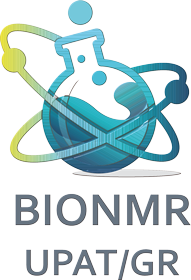RNA and DNA binding proteins
In our lab we study the structure-function relationship of RNA and DNA binding proteins. We mainly are interested in nucleic acid binding proteins having eukaryotic and viral origin. The eukaryotic domains that we investigate are implicated in many steps of cellular cycle as transcriptional and translational regulators, while the viral are important components for the viral life cycle. The structural characterization of these proteins and their interaction with their partners (nucleic acid, proteins, small molecules) are investigated through high resolution NMR spectroscopy and other biophysical techniques. Amongst them, the La protein, an RNA chaperon protein from human and D. discoideum, and their interactions with t-RNA molecules have been studied thoroughly. Viral macro domains as well as metal binding domains from Alphaviruses and beta-Coronaviruses, parts of their RTCs (replication-transcription-complex) are also included in our research projects.
COVID-19
We are working NMR backbone and sidechains assignment and structure determination of protein domain of COVID-19 non structural Protein3 (nsP3b and nsP3C). Our laboratory is actively involved in the COVID19-NMR consortium (https://covid19-nmr.de/). We have already assigned six different proteins: three Macro Domains of SARS-CoV-2, SARS-CoV, MERS in the apo and ADPr bound form; the three Sars Unique Domains–SUDs SUD-N, SUD-M, SUD-C. We have also determined the structure of SUD-C by NMR spectroscopy.
Proteins in ubiquitination pathway
Ubiquitin post-translational modification is the result of the sequential action of three enzymes, E1 ubiquitin activating enzyme, E2 conjugating enzyme and E3 ubiquitin ligase. Our interest focuses on Arkadia/RNF111 and Arkadia2C/RNF165 E3 ubiquitin ligases ubiquitination mechanisms. Specifically, we are studying the interaction of Arkadia and Arkadia2C with UbcH5b, UbcH7 and UbcH13-mms2 E2 enzymes, through NMR spectroscopy. Interestingly, during the last decade non-covalent interactions of E2-Ub, E2-E3 and E3-Ub found to play a crucial role in poly-ubiquitination process apart from the canonical ones. Whether Arkadia’s and Arkadia2C’s ubiquitination machinery includes non-covalent interactions is among our research objectives. To achieve our goals, we combine biophysical along with biochemical techniques, including ubiquitination, oxyester hydrolysis and luciferase assays.
Gas sensing heme proteins
One of our research goals is to understand the structural, electronic and functional properties of heme proteins, involved in the NO-cGMP signaling pathway. We focus on the gas-selectivity (NO, CO, O2) of human soluble guanylate cyclase (sGC) and bacterial analogues of the H-NOX domain of sGC, by implementing different spectroscopic techniques (NMR, CD and UV-vis spectroscopy). Furthermore, we study H-NOX proteins as pharmaceutical targets, through the interaction with chemical compounds which activate or stimulate the action of human sGC
Analysis and NMR-based Metabolomics
The major metabolomic tool is nuclear magnetic resonance (NMR) spectroscopy. Our lab is fully equipped to study multiple aspects of NMR applications, exploiting 1H, 13C and 15N nuclei information. Using the appropriate software, we detect and quantify metabolites from NMR spectra. Our analyses include:
- Cell extracts /Cell media
- Human and animal tissue extracts (i.e. biopsy sample)
- Body fluids (blood plasma/serum, urine, saliva, amniotic/cerebral/pancreatic/prostatic fluids, etc.)
- Food, nutrients (general metabolite analysis) composition analysis
A simple 1D 1H NMR spectrum of a biofluid or an extract, is often sufficient to identify and quantify up to 50–100 of low molecular weight metabolites per sample. This spectrum constitutes a metabolic profile and can be served as a snapshot of the physiological status of an organism, depicting its dynamic alterations. The contribution of metabolomics in clinical research comprise the characterization of the metabolic signature of a condition with a diagnostic and a prognostic scope. Furthermore, NMR metabolomics can be utilised as a tool to monitor the individual susceptibility to medications, medical interventions but also less invasive factors as environmental factors.
In our lab we have experience of a broad range of biological matrices. The majority of samples are of human origin (urine, plasma, serum, EBC, tissue and cells extracts) but we also have the experience in handling samples from bacterial cell cultures, bacterial extracts (biopolymers, surfactants & emulsifiers) and extracts from natural products.

